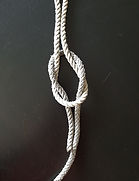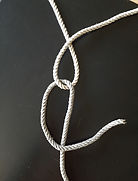
COMMON KNOTS
Tying knots is a very important skill, not just in diving but in life. From securing objects from falling over, to just tying our shoe laces, everyone uses knots. This is especially true in the nautical world where we must tie up boat and secure lifelines, as well as the underwater world where we must prep lift bags and DSMBs.
This post will guide you through three of the most common knots - the Sheet Bend, the Clove Hitch and the Half Hitch - in boating and diving. For a how to of the most common knot, check out my post on the Bowline.


When we're working with rope there are only two real terms you need to know. The working end of the rope is the end your tying up, and the standing part is the end that is fixed or under tension.
SHEET BEND
The Sheet Bend is used to tie together two pieces of rope of different thicknesses.
To start you must form an eye with one piece of rope; preferably the thicker one. Bring the working end of the thinner rope under the eye, then around the back of the eye.


Bring the working end back over top of the eye, then through it. Then pull tight.


CLOVE HITCH
The Clove Hitch is a good binding knot, however it can become undone if constant pressure is not maintained. It is good for tying boats to posts, or heaving lines to guard rails. It is one of the knots the Canadian Coast Guard requires you to learn in commercial vessel operators courses.
To start, wrap your working end over your post and bring it around the back. Then bring it back over the post, on the other side of the standing end.


Next, wrap the working end around the back of your post again, then around and under the loop you created. When it is loose it should form an eight. Then just pull tight.



TWO HALF HITCHES
The Half Hitch is probably the most common knot of all. It is some times referred to as a granny knot. Although the Half Hitch is a knot on its own, your rarely see just one. Two Half Hitches is common in diving and boating practices. I like this knot because it is so easy, in an emergency anyone can quickly untie it, even if they know nothing about knots.
Start by threading your working end through your eye, ring, loop or whatever you're tying to. Then wrap your working end over your standing part.


Next, bring your working end back under the standing part and over the loop you created with your working end. Pull tight, and you have a single Half Hitch. Just repeat the process for the second one. Wrap your working end around your standing part, through your loop and pull tight. You can do this as many times as you like to create as many Half Hitches as necessary.




